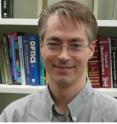Pitt researchers create atomic-sized one-stop shop for nanoelectronics
University of Pittsburgh researchers have created a nanoscale one-stop shop, a single platform for creating electronics at a nearly single-atom scale that could yield advanced forms of such technologically important devices as high-density memory devices and—most importantly—transistors and computer processors. This multitude of uses stems from a technique previously developed by the same team to fashion rewritable nanostructures at the interface between two insulating materials. In the Feb. 20 edition of Science, the researchers demonstrate this process' various applications. "We've demonstrated that we can make important technologies that are significantly smaller than existing devices and all from the same material," said Jeremy Levy, the Science paper's senior author and a professor of physics and astronomy in Pitt's School of Arts and Sciences. "To sustain the development of smaller and faster computers, we will probably need to transition away from existing materials in the coming decade. The memory bits in magnetic hard drives are about as small as they can get; silicon transistors will get increasingly difficult to miniaturize. We have created advanced storage and processing capability using the same material, presenting a totally new flexibility in building electronics."
Levy and his team reported in Nature Materials in March 2008 that their process of swapping insulators and conductors works like a microscopic Etch A SketchTM, the drawing toy that inspired Levy's idea. Using the sharp conducting probe of an atomic force microscope, he created wires less than 4 nanometers wide at the interface of a crystal of strontium titanate and a 1.2 nanometer thick layer of lanthanum aluminate, both of which are insulators. The conducting nanowires could then be erased with a reverse voltage or with light, rendering the interface an insulator once more.
The current publication in Science illustrates that the potential of this process extends beyond simple insulators and conductors—it can be tailored to specific uses, most notably field-effect transistors (FETs), the building blocks of computers and electronics. Levy and his colleagues fashioned a transistor they call a "SketchFET" with feature sizes of only two nanometers—considerably smaller than the most advanced silicon transistor, which measures 45 nanometers. Given the SketchFET's small size, many more transistors could be packed into a single device.
The SketchFET seems to have notable similarities to silicon transistors, said Alexander Bratkovsky, a senior scientist in the Information and Quantum Systems Lab at HP Labs, the central research facility for Hewlitt-Packard, who is familiar with Levy's work.
"The channel current-voltage characteristics of the SketchFET look very close to a silicon transistor and its characteristics look promising," he said. "In terms of simplicity, it's striking. Transistors are typically laid out in many layers. The whole idea that you can take a single buried oxide interface and form structures almost by writing it in a two-dimensional layout is very interesting. It's an elegant piece of research with a lot of potential for electronics and sensors. It indicates that there could be other interesting developments and uses for oxide interfaces with an unexpectedly high mobility of carriers localized near the interface."
The SketchFET transistor can be erased at will and replaced with other devices such as high-density memory, wiring, or chemical sensors that could rival the ultra-sensitive detectors made from carbon nanotubes. Because the sensitive region of Levy's proposed sensor can be the same size as a single molecule, it can be used to sense the presence or absence of a single molecule, making it ideal for chemical and biological sensing technologies, he explained.
Additionally, the scale of these components is such that fundamental properties of quantum mechanics too complex to simulate with ordinary computers can be observed. So-called quantum "tunneling"—in which electrons pass through forbidden regions—was directly observed and controlled. Such behavior also may be useful in quantum simulations of novel electronic materials, and for the construction of a quantum computer.
Altogether, the Pitt team has introduced a relatively practical method for working with nanotechnology and tailoring it to various applications, said Evelyn Hu, Gordon McKay Professor of Applied Physics and Electrical Engineering in Harvard University's School of Engineering and Applied Sciences.
"They have created devices on demand by writing patterns with an atomic force microscope and, in doing so, they are opening up numerous new applications," Hu said. "To take a blank sheet and write in the electronic function is accomplishment enough, but to do that then erase it and create a completely different function is truly powerful. They have laid the groundwork for a new technology that can take on many forms.
"Their approach has particular benefits for nanoelectronics," she continued. "Working with nanoscale devices usually requires precise definition and placement of the component structures. Fine-tuning a device or structure is often tedious and expensive. This method, however, allows for ease and flexibility in forming and re-forming the device after the initial preparation. These devices, in their fabrication and generation of electric charge, illustrate a cognizance of the unique potential and challenges of the nanoscale."
The idea for the Etch A SketchTM process originated from a visit Levy made to the University of Augsburg in Germany where the Science paper's coauthors, Jochen Mannhart and his student Stefan Thiel, showed Levy how the entire interface could be switched between a conducting and insulating state. Levy thought of adapting the process to nanoscale dimensions, and his student and coauthor, Cheng Cen, brought the idea to fruition.
Source: University of Pittsburgh
Other sources
- Researchers create atomic-sized one-stop shop for nanoelectronics (Video)from PhysorgThu, 19 Feb 2009, 20:14:15 UTC
